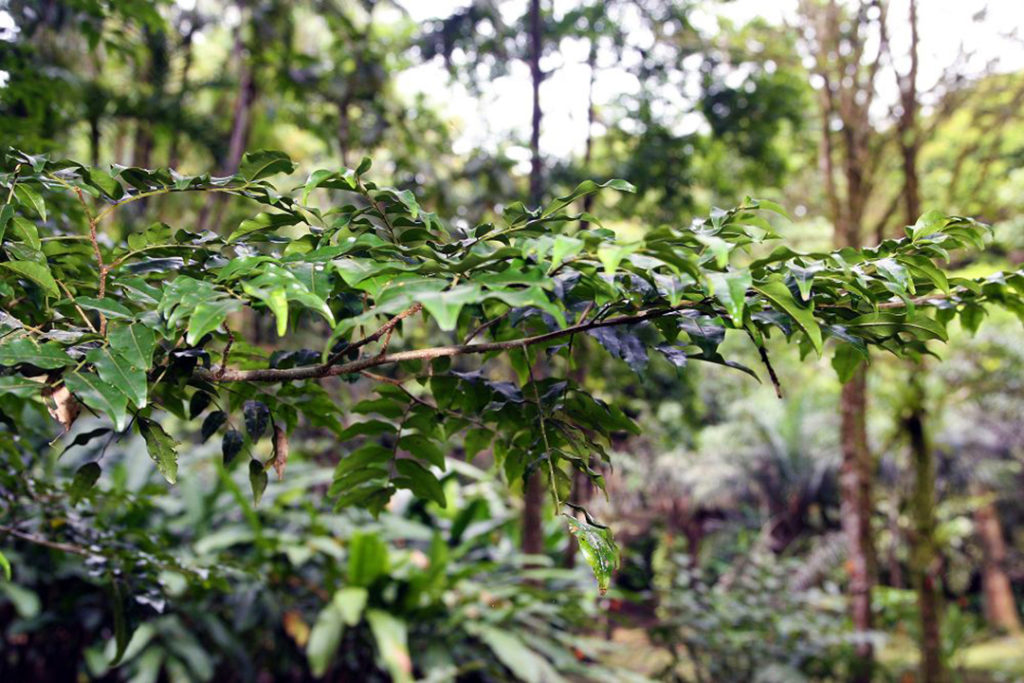
Holy See “Vatican City”
Balsam
Myroxylon balsamum, Myroxylon toluiferum, and other Balsam species

General Description / Cultural Significance
Balsam, Myroxylon balsamum, is among the plants incorporated in papal incense and therefore incredibly meaningful to priests and disciples in Vatican City, the capital of the Catholic Church. Since antiquity, incense has been used in the Christian faith to bless, sanctify, and purify. In the bible, it was notably one of the gifts from the three wise men to Jesus. The white resin produced from balsam is used to create a strong fragrance and thicken the smoke of burning incense, which rises and represents ascension to heaven. The fragrance of balsam represents the “aroma of Christ.” The oil of balsam is also mixed with olive oil by a priest who consecrates it by saying a prayer, at which point it becomes a precious and holy gift.
This resin used in these rituals is obtained from the sap of the Balsam tree, which leaks and hardens and is then powdered and used as incense. Peru and Tolu species of balsam are used as frankincense and mixed with other species such as Balm of Gilead or pine. Balsam is also often distilled and used in perfumes. It is widely thought that balsam brings spiritual, emotional, and physical healing, as well as comfort.
The Illustrated Dictionary & Concordance of the Bible, published in Jerusalem, states that “the aromatic resin was extracted from the opobalsamum tree, which grows round Mecca. Large balsam plantations between Jericho and En Gedi in the time of the Second Temple” (the time of Herod the Great).
Climate Change/Conservation Status
In 2020, Pope Francis committed the Vatican to reduce its carbon emissions to net zero by 2050 and strongly urged other countries to work to do the same. He backed the Paris Agreement and stated that the Vatican aimed to reach 75% waste recycling by the year 2023, and they are moving to substitute all cars with electric or hybrid models in the city-state. Pope Francis repeated Pope Paul’s message in his encyclical letter of 2015 stating, “due to an ill-considered exploitation of nature, humanity runs the risk of destroying it and becoming in turn a victim of this degradation”. Pope Francis said it was the moral responsibility of all people to care for the earth and that humanity must radically change its conduct. He has arranged many Vatican conferences on climate change with the Pontifical Academy of Sciences. As a moral authority, the pope holds much power, and so his practical changes and his general stance regarding the climate crisis are encouraging for the rest of the planet.
More broadly, the Italian region’s temperatures have already been rising and they have been facing heavy precipitation patterns. Extreme weather has become far more frequent. Tornados and floods have been causing damage and death. The melting of Italian glaciers and the subsequent rise in sea levels is a major threat to low-lying coasts.
As far as balsam goes, the tree is endangered in some parts of the world. The IUCN listed it as threatened in 2017. According to a few reports, balsam is threatened due to the high demand for essential oils and incense. Resin over-harvesting and drought conditions, as well as unprotected forests in Somaliland, are a problem, as this region sells frankincense to other countries and is a major source for the Roman Catholic Church. Farmers who produce frankincense are also exploited for their labor and underpaid. Better sustainability standards are needed to protect this sacred species, and fair-trade prices are needed to protect the people farming it.
As climate change is an unprecedented threat to all living systems on earth, it is implicated in any negative changes with balsam plants in the natural ranges where they grow.
In 2023, Pope Francis took a powerful stand against fossil fuels, stating “the world must rapidly ditch fossil fuels and end ‘the senseless war against creation.’” He called on all people to repent for their “ecological sins.”
Alternate Names
Gum olibanum
Santos mahogany
Tolu balsam
Chester, J., 2017. What Are the Ingredients in the Incense at Catholic Mass? Leaf Group Ltd. [website]
Emmons, D.D., n.d. What are the Three Holy Oils? Our Sunday Visitor. [website]
The Local List, 2015. How climate change will devastate Italy. The Local Europe AB. [website]
Meehan, A., 1907. “Balsam.” In The Catholic Encyclopedia. New York: Robert Appleton Company.
Permanent Observer Mission of the Holy See to the United Nations. This statement can be found on the World Sensorium original website.
Pullella, P., 2020. Pope commits Vatican to net zero carbon emissions by 2050. Reuters. [website]
Sadowski, K., 2017. Threatened/Endangered Essential Oil Species. Earth to Kathy. [website]
Yager, M., & Yager, J., 2008. A Call for Conservation. Incense-Making. [website]
Zavada, J., 2020. What is Frankincense? Learn Religions. [website]
2023. Enough with fossil fuels, Pope says in latest climate appeal. Reuters. Available from https://www.reuters.com/business/environment/enough-with-fossil-fuels-pope-says-latest-climate-appeal-2023-05-25/
2015. Encyclical Letter Laudato Si’ of the Holy Father France on Care for Our Common Home. The Holy See. Available from https://www.vatican.va/content/francesco/en/encyclicals/documents/papa-francesco_20150524_enciclica-laudato-si.html

